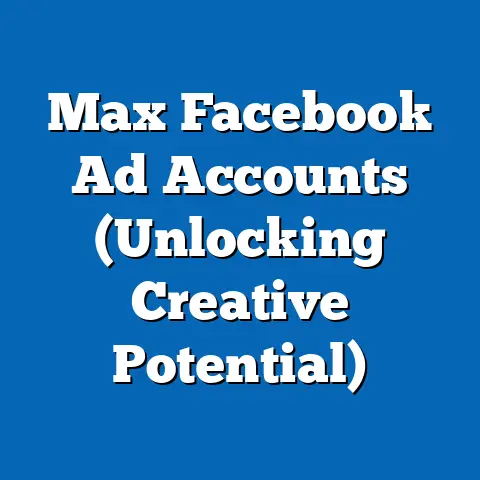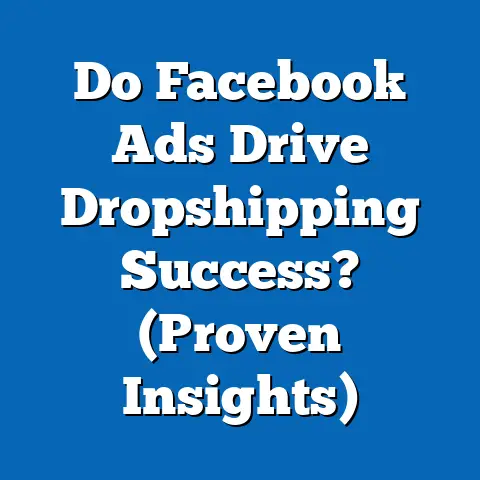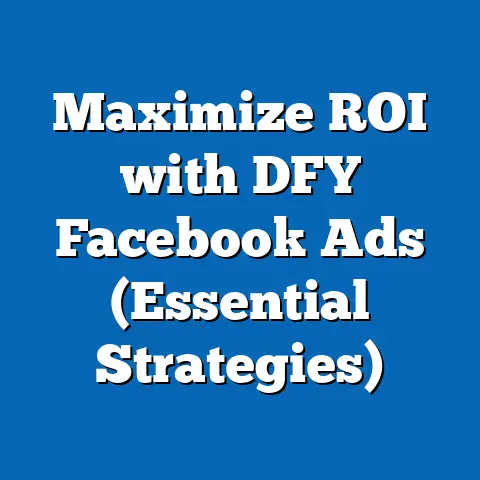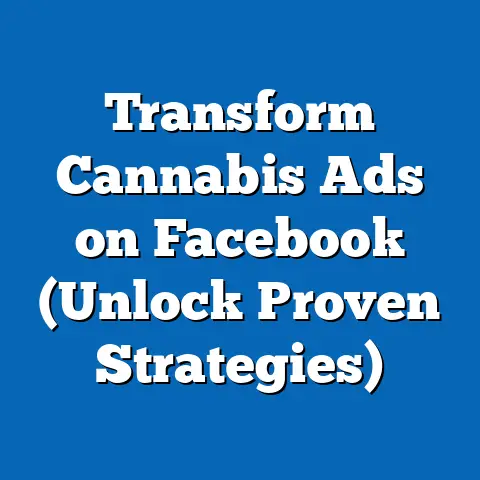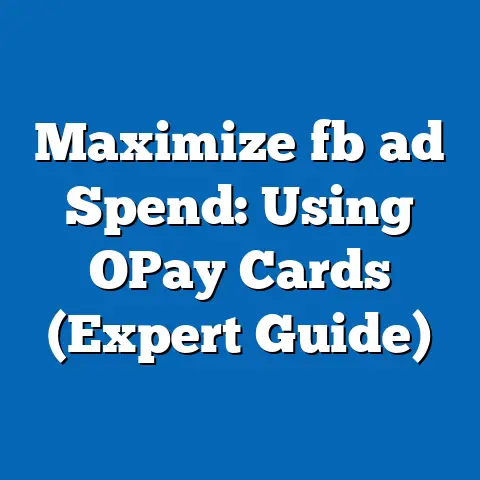Unlock fb ad Insights (Maximize Engagement with Comments)
I remember when I first started running Facebook ads for my small online store. I poured hours into crafting the perfect visuals and writing compelling copy, convinced that I was about to see a flood of sales. But the reality was… underwhelming. My ads were getting impressions, sure, but engagement was practically non-existent. It felt like I was shouting into a void, and the silence was deafening. I knew I had to figure out what was going wrong, and that’s when I truly started diving deep into Facebook Ad Insights.
That experience, the frustration and the eventual breakthrough, is why I’m so passionate about helping other businesses unlock the power of Facebook Ads. And a critical piece of that puzzle? Understanding and maximizing engagement with comments. Comments are more than just fleeting interactions; they’re a goldmine of insights into what your audience really thinks and feels. They’re a chance to build relationships, address concerns, and ultimately drive conversions.
1. Understanding Facebook Ad Insights
Facebook Ad Insights is, in essence, your window into the performance of your advertising campaigns. It’s the data hub that provides you with a wealth of information about how users are interacting with your ads and, more importantly, what those interactions mean for your business.
What are Facebook Ad Insights?
Think of Facebook Ad Insights as your campaign’s report card. It’s a comprehensive analytics tool that allows you to track and analyze various metrics related to your Facebook ads. It provides data on everything from how many people saw your ad (impressions) to how many clicked on it (link clicks) and, crucially, how many engaged with it through likes, shares, and, of course, comments.
Why are they Important?
Facebook Ad Insights are essential for a few key reasons:
- Optimization: Without data, you’re flying blind. Ad Insights provide the information you need to optimize your campaigns, refine your targeting, and improve your ad creative. You can see what’s working and what’s not, allowing you to make informed decisions.
- Audience Understanding: Insights help you understand your audience better. You can see demographics, interests, and behaviors of the people who are engaging with your ads. This helps you tailor your messaging and targeting for future campaigns.
- Budget Allocation: By understanding which ads are performing well, you can allocate your budget more effectively. You can focus your spending on the campaigns that are driving the best results, maximizing your ROI.
- Performance Measurement: Ad Insights allow you to track your progress over time. You can see how your campaigns are performing against your goals and identify trends that can inform your overall marketing strategy.
Key Metrics in Facebook Ad Insights
Here are some of the most important metrics you’ll find in Facebook Ad Insights:
- Impressions: The number of times your ad was displayed to users. A high number of impressions indicates that your ad is being seen by a large audience, but it doesn’t necessarily mean they’re engaging with it.
- Reach: The number of unique users who saw your ad. Reach is different from impressions because one user can see your ad multiple times.
- Engagement Rate: This metric measures the percentage of users who interacted with your ad after seeing it. Engagement includes likes, shares, comments, and clicks. A high engagement rate indicates that your ad is resonating with your audience.
- Click-Through Rate (CTR): The percentage of users who clicked on your ad after seeing it. A high CTR indicates that your ad is compelling and relevant to your audience.
- Cost Per Click (CPC): The average cost you pay each time someone clicks on your ad. This metric is important for managing your budget and optimizing your ad spend.
- Conversion Metrics: These metrics track the number of users who took a desired action after clicking on your ad, such as making a purchase, signing up for a newsletter, or downloading a resource.
- Cost Per Acquisition (CPA): The average cost you pay for each conversion. This is a critical metric for measuring the ROI of your advertising campaigns.
- Relevance Score (Deprecated): While Facebook has deprecated the Relevance Score, it’s worth mentioning briefly. It was a metric that assessed the relevance of your ad to your target audience. Although no longer actively used, it underscored the importance of targeting and ad quality.
Interpreting Ad Insights
It’s not enough to simply collect data; you need to interpret it effectively. Here are some tips for interpreting Facebook Ad Insights:
- Track Trends Over Time: Don’t just look at data in isolation. Track your metrics over time to identify trends and patterns. This will help you understand how your campaigns are performing in the long run.
- Compare Different Ads: Compare the performance of different ads to see which ones are resonating with your audience. This will help you refine your ad creative and messaging.
- Segment Your Data: Segment your data by demographics, interests, and behaviors to understand how different groups of users are responding to your ads. This will help you tailor your targeting for future campaigns.
- Consider External Factors: Keep in mind that external factors, such as seasonality and current events, can impact your ad performance. Take these factors into account when interpreting your data.
Takeaway: Facebook Ad Insights are your key to unlocking successful Facebook advertising. By understanding the metrics and interpreting them effectively, you can optimize your campaigns, improve your targeting, and maximize your ROI.
Next Step: Familiarize yourself with the Facebook Ads Manager interface and explore the different metrics available in Ad Insights. Start tracking your campaigns and identify areas for improvement.
2. The Power of Comments in Engagement
While metrics like impressions and reach tell you how many people are seeing your ads, comments tell you how many people are connecting with them. They represent a deeper level of engagement and provide valuable insights into your audience’s thoughts and feelings.
What are Comments?
In the context of Facebook ads, comments are user-generated responses to your ad content. They are a form of direct interaction that allows users to share their opinions, ask questions, and engage in discussions related to your ad.
Why are Comments Important?
Comments are more than just fleeting interactions. They offer a wealth of benefits for your Facebook ad campaigns:
- Increased Visibility: Comments can increase the visibility of your ads. When users comment on your ad, it can be seen by their friends and followers, expanding your reach organically.
- Improved Engagement: Comments are a direct form of engagement, indicating that users are interested in your ad content. High comment volume can boost your engagement rate, signaling to Facebook that your ad is relevant and valuable.
- Valuable Feedback: Comments provide valuable feedback about your ad content, products, or services. You can learn what users like, what they dislike, and what questions they have.
- Community Building: Comments can foster a sense of community around your brand. By engaging with users in the comments section, you can build relationships, address concerns, and create a loyal following.
- Social Proof: Positive comments can serve as social proof, influencing other users to trust your brand and consider your products or services.
- SEO Benefits: While the direct impact on SEO is debated, the increased engagement from comments can indirectly improve your website’s search engine ranking.
Statistics and Case Studies
Here are some statistics and case studies that demonstrate the power of comments in engagement:
- According to a study by Sprout Social, 70% of consumers feel more connected to brands when they respond to their feedback on social media.
- A case study by HubSpot found that businesses that actively engage with their audience on social media generate 50% more leads.
- A study by Mention found that comments are the most engaging type of interaction on social media, with a higher engagement rate than likes or shares.
The Psychology Behind Comments
Understanding the psychology behind why users comment on ads can help you craft ad copy that prompts engagement:
- Sharing Opinions: Users often comment to share their opinions about your ad content, products, or services. They may want to express their agreement, disagreement, or offer their own perspective.
- Asking Questions: Users may comment to ask questions about your ad, products, or services. They may want to clarify information, seek advice, or learn more about your brand.
- Seeking Validation: Users may comment to seek validation from others. They may want to share their experiences, solicit opinions, or connect with like-minded individuals.
- Expressing Emotions: Users may comment to express their emotions, such as excitement, humor, or frustration. They may want to share their feelings, connect with others, or seek support.
- Building Relationships: Users may comment to build relationships with brands and other users. They may want to connect with like-minded individuals, share their experiences, or seek advice.
Takeaway: Comments are a powerful form of user engagement that can increase visibility, improve engagement rates, provide valuable feedback, foster community, and serve as social proof.
Next Step: Start paying attention to the comments on your Facebook ads. Analyze what users are saying and identify opportunities to engage with them.
3. Strategies to Encourage Comments on Ads
Now that you understand the power of comments, let’s explore some strategies you can use to encourage them on your Facebook ads.
Ad Formats That Generate More Comments
Certain ad formats tend to generate more comments than others. Here are some of the most effective:
- Video Ads: Video ads are highly engaging and can often spark conversations. They allow you to tell a story, showcase your products, and connect with your audience on an emotional level.
- Carousel Ads: Carousel ads allow you to showcase multiple products or features in a single ad. This can be a great way to generate comments by asking users to choose their favorite product or feature.
- Story Ads: Story ads are immersive and visually appealing. They can be a great way to capture attention and generate comments by asking users to share their thoughts or experiences.
- Poll Ads: Poll ads are interactive and encourage users to participate. They can be a great way to generate comments by asking users to vote on a question or express their opinion.
- Live Video Ads: Live video ads are authentic and engaging. They allow you to connect with your audience in real-time and answer their questions live.
Crafting Compelling Ad Copy
Your ad copy plays a crucial role in prompting users to comment. Here are some tips for crafting compelling ad copy:
- Ask Open-Ended Questions: Open-ended questions encourage users to share their thoughts and opinions. Avoid questions that can be answered with a simple “yes” or “no.”
- Create Polls: Polls are a fun and engaging way to generate comments. Ask users to vote on a question or express their opinion.
- Use Humor: Humor can be a great way to capture attention and generate comments. Just make sure your humor is appropriate for your target audience and brand.
- Tell a Story: Stories are engaging and can connect with your audience on an emotional level. Share a story that relates to your product or service and ask users to share their own experiences.
- Create Controversy: Controversy can generate a lot of comments, but be careful. Make sure your controversy is relevant to your brand and target audience, and avoid anything that could be offensive or harmful.
- Run Contests and Giveaways: Contests and giveaways are a great way to generate comments and engagement. Ask users to comment on your ad to enter the contest or giveaway.
The Role of Visuals and Storytelling
Visuals and storytelling are essential for drawing comments and fostering discussions. Here are some tips for using visuals and storytelling effectively:
- Use High-Quality Images and Videos: Your visuals should be high-quality and visually appealing. They should capture attention and convey your message effectively.
- Tell a Story: Stories are engaging and can connect with your audience on an emotional level. Use visuals to help tell your story and create a lasting impression.
- Showcase Your Products: Use visuals to showcase your products or services in action. This can help users understand the value of your offerings and prompt them to comment with questions or feedback.
- Use User-Generated Content: User-generated content is authentic and can build trust with your audience. Ask users to share their photos or videos of your products or services and feature them in your ads.
Takeaway: Certain ad formats, compelling ad copy, and effective visuals and storytelling can all contribute to generating more comments on your Facebook ads.
Next Step: Experiment with different ad formats, ad copy, and visuals to see what works best for your target audience. Track your results and refine your strategies accordingly.
4. Analyzing Comments for Valuable Insights
Generating comments is only half the battle. The real magic happens when you analyze those comments to gain valuable insights into your audience’s sentiments and preferences.
Categorizing and Analyzing Comments
Not all comments are created equal. Some are positive, some are negative, and some are simply neutral. Here’s how to categorize and analyze them:
- Sentiment Analysis: Sentiment analysis is the process of determining the emotional tone of a comment. You can use sentiment analysis tools to automatically categorize comments as positive, negative, or neutral.
- Topic Analysis: Topic analysis is the process of identifying the main topics or themes discussed in the comments. You can use topic analysis tools to automatically identify the most common topics and understand what users are talking about.
- Manual Review: Manual review is the process of reading and categorizing comments manually. This can be time-consuming, but it allows you to gain a deeper understanding of the nuances of each comment.
The Importance of Monitoring Positive and Negative Comments
Monitoring both positive and negative comments is crucial for understanding your audience’s sentiments and preferences.
- Positive Comments: Positive comments can provide valuable feedback about what users like about your ad content, products, or services. They can also serve as social proof, influencing other users to trust your brand.
- Negative Comments: Negative comments can provide valuable feedback about what users dislike about your ad content, products, or services. They can also help you identify areas for improvement and address customer concerns.
How Comments Can Inform Future Ad Strategies
The insights you gain from analyzing comments can inform your future ad strategies in several ways:
- Refining Ad Copy: Comments can provide insights into what language and messaging resonates with your audience. Use this information to refine your ad copy and make it more compelling.
- Improving Targeting: Comments can provide insights into the demographics, interests, and behaviors of your target audience. Use this information to improve your targeting and reach the right people.
- Developing New Products and Services: Comments can provide insights into what products and services your audience wants. Use this information to develop new offerings that meet their needs.
- Addressing Customer Concerns: Comments can provide insights into customer concerns and complaints. Use this information to address those concerns and improve customer satisfaction.
Tools and Techniques for Tracking and Managing Comments
There are several tools and techniques you can use to track and manage comments effectively:
- Facebook Ads Manager: Facebook Ads Manager provides a built-in tool for tracking and managing comments. You can view all comments on your ads in one place and respond to them directly.
- Social Media Management Tools: Social media management tools, such as Hootsuite and Buffer, allow you to track and manage comments across multiple social media platforms.
- Sentiment Analysis Tools: Sentiment analysis tools, such as Brandwatch and Mention, allow you to automatically categorize comments as positive, negative, or neutral.
- Comment Moderation Guidelines: Develop comment moderation guidelines to ensure that all comments are respectful and appropriate. This will help you maintain a positive brand image and create a welcoming community.
Takeaway: Analyzing comments can provide valuable insights into your audience’s sentiments and preferences, which can inform your future ad strategies and improve your overall marketing efforts.
Next Step: Start analyzing the comments on your Facebook ads. Use sentiment analysis tools, topic analysis tools, and manual review to gain a deeper understanding of your audience.
5. Responding to Comments for Maximum Impact
Responding to comments is not just about being polite; it’s about building relationships, fostering trust, and maximizing the impact of your Facebook ads.
The Significance of Timely and Thoughtful Responses
Timely and thoughtful responses are crucial for several reasons:
- Show You Care: Responding to comments shows that you care about your audience’s opinions and concerns. This can build trust and loyalty.
- Address Concerns: Responding to negative comments can help you address customer concerns and resolve issues. This can prevent negative feedback from spreading and damaging your brand reputation.
- Encourage Engagement: Responding to comments can encourage further engagement. When users see that you’re actively participating in the conversation, they’re more likely to comment themselves.
- Provide Information: Responding to comments can provide valuable information to your audience. You can answer questions, clarify information, and provide helpful resources.
Enhancing Brand Loyalty and Trust
Engaging with users in the comments section can enhance brand loyalty and trust in several ways:
- Personalization: Personalizing your responses shows that you’re not just a faceless corporation. Use the commenter’s name and address their specific concerns.
- Empathy: Showing empathy for your audience’s concerns can build trust and rapport. Acknowledge their feelings and offer solutions.
- Transparency: Being transparent about your brand’s values and practices can build trust. Share information about your company culture, ethical sourcing, and commitment to customer satisfaction.
- Responsiveness: Being responsive to comments shows that you value your audience’s time and attention. Respond to comments quickly and efficiently.
Examples of Effective Responses
Here are some examples of effective responses that not only acknowledge the commenter but also encourage further conversation:
- Positive Comment: “Thank you so much for your kind words! We’re so glad you enjoyed our product. What’s your favorite feature?”
- Negative Comment: “We’re so sorry to hear you had a negative experience. We’d like to learn more about what happened so we can make things right. Could you please send us a private message with more details?”
- Question: “That’s a great question! The answer is… [provide a clear and concise answer]. Do you have any other questions we can answer?”
Takeaway: Responding to comments is a crucial part of your Facebook ad strategy. Timely and thoughtful responses can enhance brand loyalty, build trust, and maximize the impact of your ads.
Next Step: Develop a comment moderation strategy and start responding to comments on your Facebook ads. Personalize your responses, show empathy, and provide valuable information.
6. Case Studies of Successful Comment Engagement
Let’s take a look at some real-world examples of brands that have successfully utilized comments to boost their ad performance.
Case Study 1: Wendy’s
Wendy’s is known for its witty and humorous social media presence. They often engage with users in the comments section with clever responses and playful banter. This has helped them build a loyal following and generate a lot of engagement on their ads.
- Strategy: Wendy’s uses humor and wit to engage with users in the comments section. They respond to comments quickly and efficiently, and they’re not afraid to poke fun at themselves or their competitors.
- Outcome: Wendy’s has built a loyal following and generates a lot of engagement on their ads. Their social media presence has helped them build brand awareness and drive sales.
Case Study 2: Dove
Dove is known for its commitment to body positivity and self-esteem. They often engage with users in the comments section to promote their message and build a supportive community.
- Strategy: Dove uses its comments section to promote its message of body positivity and self-esteem. They respond to comments with empathy and support, and they encourage users to share their own stories.
- Outcome: Dove has built a strong community of supporters and generates a lot of engagement on their ads. Their social media presence has helped them build brand awareness and drive sales.
Case Study 3: Nike
Nike is known for its innovative and inspiring marketing campaigns. They often engage with users in the comments section to promote their products and build a connection with their audience.
- Strategy: Nike uses its comments section to promote its products and build a connection with its audience. They respond to comments with enthusiasm and encouragement, and they often share behind-the-scenes content.
- Outcome: Nike has built a strong brand image and generates a lot of engagement on their ads. Their social media presence has helped them build brand awareness and drive sales.
Innovative Tactics to Inspire Your Strategy
These case studies highlight several innovative tactics you can use to inspire your own comment engagement strategy:
- Use Humor: Humor can be a great way to capture attention and generate comments.
- Promote Your Message: Use your comments section to promote your brand’s values and beliefs.
- Build a Community: Use your comments section to build a supportive community around your brand.
- Share Behind-the-Scenes Content: Sharing behind-the-scenes content can help you build a connection with your audience.
Takeaway: These case studies demonstrate that successful comment engagement requires a clear strategy, a consistent voice, and a commitment to building relationships with your audience.
Next Step: Analyze the comment engagement strategies of successful brands in your industry. Identify tactics that you can adapt and implement in your own Facebook ad campaigns.
7. Future Trends in Facebook Ads and Comment Engagement
The world of Facebook advertising is constantly evolving, and comment engagement is no exception. Let’s take a look at some future trends that may impact your strategy.
Evolving Algorithms
Facebook’s algorithms are constantly changing, and this can impact the visibility of comments. In the future, it’s likely that Facebook will prioritize comments that are more relevant and engaging. This means that you’ll need to focus on creating high-quality ad content and fostering meaningful conversations in the comments section.
The Rise of Artificial Intelligence (AI)
AI is already playing a role in Facebook advertising, and it’s likely to become even more important in the future. AI can be used to automate comment moderation, analyze sentiment, and even generate responses. This can help you save time and improve the efficiency of your comment engagement strategy.
The Metaverse and Immersive Experiences
The metaverse is a virtual world where users can interact with each other and with digital content. In the future, it’s possible that Facebook ads will be integrated into the metaverse, allowing users to interact with your brand in new and immersive ways. This could create new opportunities for comment engagement, such as virtual product demonstrations and live Q&A sessions.
New Features and Changes in Facebook’s Advertising Platform
Facebook is constantly rolling out new features and changes to its advertising platform. It’s important to stay up-to-date on these changes and adapt your comment engagement strategy accordingly. For example, Facebook may introduce new ad formats that are more conducive to comment engagement, or they may change the way comments are displayed in the news feed.
How to Stay Ahead
Here are some tips for staying ahead of the curve in the world of Facebook ads and comment engagement:
- Stay Informed: Read industry blogs, attend webinars, and follow social media experts to stay up-to-date on the latest trends.
- Experiment: Don’t be afraid to experiment with new ad formats, ad copy, and comment engagement strategies.
- Analyze Your Results: Track your results and refine your strategies accordingly.
- Embrace Technology: Embrace new technologies, such as AI, to automate and improve your comment engagement strategy.
Takeaway: The future of Facebook ads and comment engagement is constantly evolving. By staying informed, experimenting, analyzing your results, and embracing technology, you can stay ahead of the curve and maximize the impact of your advertising campaigns.
Next Step: Start researching the latest trends in Facebook ads and comment engagement. Identify opportunities to experiment with new strategies and technologies.
Conclusion: The Emotional Connection
Remember that small business owner I mentioned at the beginning? The one struggling with lackluster engagement on their Facebook ads? By understanding and leveraging comments, they can transform their advertising experience from frustration to success.
It’s about more than just generating clicks and impressions; it’s about fostering genuine connections with your audience. It’s about creating a community around your brand and building trust with your customers.
I urge you to embrace the power of comments as a vital aspect of your Facebook ad strategy. Don’t just see them as fleeting interactions; see them as opportunities to engage, connect, and build relationships.
By doing so, you’ll not only drive engagement and conversions but also create a more meaningful and rewarding advertising experience for both you and your audience.
So, go out there and start the conversation. Your audience is waiting to hear from you.

